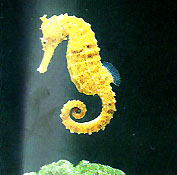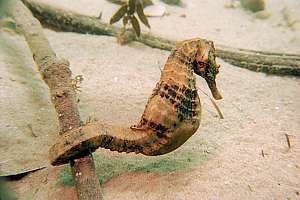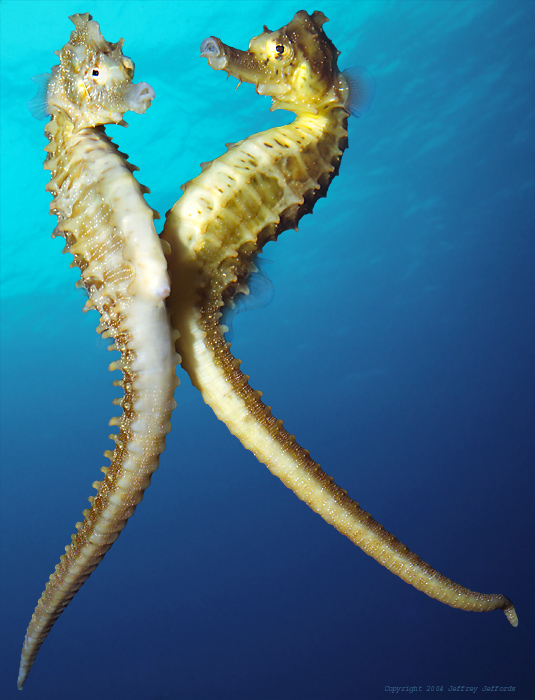Biology Forum › Zoology Discussion › Urgent: Seahorses
- AuthorPosts
- January 26, 2006 at 12:39 pm #3359
 Dr.SteinParticipant
Dr.SteinParticipantHello,
I am planning to write a book about "The Uses of Seahorses (Hippocampus sp.) In Medicinal And Magical Aspects". This is still a tentative title. To be precise, it will be just a compilation of usage of seahorses from worldwide. So far I already have some references for it, but I need more and more to make it such a complete book, if cannot be a complete one, at least I hope it will be a good book 😉
If you are interested to contribute in this project, you can send me the articles here, whatever, textbook citation, journals, (scientific) magazine, or links are ok. Sooner, better. Your name (or nickname, because I do not know your real name) will be listed in the acknowledgment section, and I try that you will get the copy of the book when it would have done. Special thanks to this forum, of course 🙂
Thank you.

P.S. If you need more info about the topic of my book, feel free to ask me here 🙂
- January 28, 2006 at 3:20 pm #38739
 LinnParticipant
LinnParticipantAre seahorses endangered?
- January 28, 2006 at 3:46 pm #38744
 MrMisteryParticipant
MrMisteryParticipantI don’t understand what is it exactly that you need. Medicinal and magic uses of sea horses?! Give an example and maybe i can start looking through my magazines
- January 29, 2006 at 5:26 am #38804
 Dr.SteinParticipant
Dr.SteinParticipantThe example of medicinal aspect is the use of seahorse for improving reproductive system, according to TCM (Traditional Chinese Medicine) (my current research).
The example of magical aspect is that some people use seahorse in animism, they believe that seahorse will keep their health and wealth.
- January 29, 2006 at 2:45 pm #38824
 LinnParticipant
LinnParticipantsorry
guess Ill just look it up. 😆 - January 30, 2006 at 8:34 am #38886
 Dr.SteinParticipantquote Linn:Are seahorses endangered?
Dr.SteinParticipantquote Linn:Are seahorses endangered?IUCN placed it in the category "Vulnerable" of the Red List 😉
- February 2, 2006 at 4:01 pm #39327
 LinnParticipant
LinnParticipantDr Stein
What do you think of this article?http://seahorse.fisheries.ubc.ca/covera … 021202.pdf
I am just wondering why you are writing this book?
Its an interesting topic - February 3, 2006 at 10:41 am #39439
 Dr.SteinParticipant
Dr.SteinParticipantAh! Thanks for your input. From that article I got these:
Medicinal aspect:
Seahorses use to treat:
1. broken bones
2. childbirth pains
3. impotenceAdditional uses:
1. as decoration/ornaments
2. as jewellery
3. as toys (there are even such things as seahorse yoyos)
4. as aquarium fodderWhy am I writing a book for this topic? I am not sure what the reason is, I just listen to something sparks in my head, and yes this is quite interesting for me 😉
Thanks again for your contribution.
- February 3, 2006 at 11:18 am #39447
 Alish24Participant
Alish24Participantmmm..I think one of my friends is studying on this subject in Turkey!!
I ll ask her for more information and ll send you..
hope it ll be useful for you! - February 3, 2006 at 12:26 pm #39459
 victorParticipant
victorParticipantwhat I know that Seahorse is not one species with Horse..:lol:
- February 4, 2006 at 2:44 pm #39579
 Dr.SteinParticipantquote Alish24:mmm..I think one of my friends is studying on this subject in Turkey!!
Dr.SteinParticipantquote Alish24:mmm..I think one of my friends is studying on this subject in Turkey!!
I ll ask her for more information and ll send you..
hope it ll be useful for you!Hey I would like to have a contact with her. We can do a project. Oh I love project 🙂 Thanks in advance 😉
- February 4, 2006 at 2:45 pm #39580
 Dr.SteinParticipantquote victor:what I know that Seahorse is not one species with Horse..:lol:
Dr.SteinParticipantquote victor:what I know that Seahorse is not one species with Horse..:lol:Smart guy 8) 😆
- February 4, 2006 at 3:46 pm #39600
 Alish24Participant
Alish24ParticipantI ll try to contact her and say her about you Dr. Stein..I think she had some projects in Blacksea and Mediterranean..meybe u ll be useful to each other 🙂
- February 4, 2006 at 4:55 pm #39622
 Dr.SteinParticipant
Dr.SteinParticipantAh ya, I like the word "collaboration" and "cooperation" 😉
… and "project" as well hehehe 😛
Thank you.
- February 5, 2006 at 12:25 pm #39710
 victorParticipant
victorParticipantOh my god !!! I’ve just known that Seahorse is a type of fish…:lol:
- February 6, 2006 at 11:06 am #39859
 victorParticipant
victorParticipanthey boss, maybe this link can help you…
http://www.seahorse.com/Frequently_Aske … medicine?/ - February 6, 2006 at 11:09 am #39860
 Dr.SteinParticipantquote victor:Oh my god !!! I’ve just known that Seahorse is a type of fish…:lol:
Dr.SteinParticipantquote victor:Oh my god !!! I’ve just known that Seahorse is a type of fish…:lol:Crazy 😆
Btw, thanks for the link. I’ve been there previously, they change the name now, it was Oceanrider.com 8)
- February 6, 2006 at 5:43 pm #39899
 opuntiaParticipant
opuntiaParticipantI don’t know if this is true, but today i heard in one of the Animal Planet’s shows, that the male sea horses are the ones that give birth to young ones…not the females, 😕 😕 😕 😕 😕
Dr.Stein, since you might already have collected a lot of information about sea horses, would you please help my curiosity to go back to sleep( 😆 ) by explaining what the female does if what i wrote above is true. - February 7, 2006 at 4:25 am #39958
 LinnParticipant
LinnParticipantthis was nagging my brain
because I remember reading about sea horses in National Geographic.
They have a few aritcles. use their search.
Here is one
🙂 from your stomping grounds:http://news.nationalgeographic.com/news … horse.html
linn 😀 - February 7, 2006 at 4:42 am #39961
 February BeetleParticipant
February BeetleParticipanti think i saw the same show as you! the male carries the females eggs like on his tummy until they are ready to hatch. I think the female kind of places them there somehow, not like opposite fertilization. Thats what i think but i’m sure Dr. Stein could tell you a lot better than me!

- February 7, 2006 at 4:50 am #39962
 LinnParticipant
LinnParticipantI love seahorse. Especially that the male does all the work! lol
I get ticked off to think people make keychains out of them.
or grind them up for some sort of medicine. they do that with tiger testicles too. aphrodisiac u 👿 know
WE could get real good imitation sea horse key chains from China. 💡
linn - February 7, 2006 at 8:23 am #39972
 opuntiaParticipant
opuntiaParticipantWell, today, i read a full article about the sea horses and it consists of many information about them…i’ll post the article as soon as i finish typing it 😀
- February 7, 2006 at 10:33 am #39986
 Dr.SteinParticipantquote opuntia:I don’t know if this is true, but today i heard in one of the Animal Planet’s shows, that the male sea horses are the ones that give birth to young ones…not the females, 😕 😕 😕 😕 😕
Dr.SteinParticipantquote opuntia:I don’t know if this is true, but today i heard in one of the Animal Planet’s shows, that the male sea horses are the ones that give birth to young ones…not the females, 😕 😕 😕 😕 😕
Dr.Stein, since you might already have collected a lot of information about sea horses, would you please help my curiosity to go back to sleep( 😆 ) by explaining what the female does if what i wrote above is true.The female lays 200-1000 eggs and direct them to male’s brood pouch (like female mammal’s uterine structure) thru a pipe processed from her belly. The male will take care of them like a pregnant female at least for 10 days until they hatch. When they are hatching, then the male starts to jerk to release them out one by one, with similar contraction like when a pregnant woman is about to deliver her baby (ouch!).
During the "male pregnancy", the female supports him with swimming around him everyday, send greeting every morning and afternoon, change her skin color periodically, and sounds like "click…click" from her jaws. This is true, I am no kidding 😉
If you see their courtship…aww, it is so romantic. It could last until three days until the female store eggs in male pouch. One thing to admire, they are monogamous, means that when one dies, cught by fisherman or predator, or something else, the left one will stay alone. She/he will get a new partner after loooooooong time or they decided to be along for her/his entire life…awwwww they are so faithful to each other 😉
Here are some figures form my collection:
Male pregnancy

Mating seahorses

Dancing seahorses (courtship dance)

Which one is male? Female?

Faithful pair

Enjoy 🙂
- February 7, 2006 at 11:33 am #40005
 victorParticipant
victorParticipantI’ve seen things about that "horse" also in animal planet and that’s why the categorized them as the most EXTREME male parents..:lol:
- February 7, 2006 at 4:17 pm #40034
 opuntiaParticipant
opuntiaParticipantSEA HORSES
The sea horse is one of the strangest creatures. It’s head is shaped like a horse’s and its tail curls like a monkey’s. It’s eyes are on stalks called " turrets", and each eye can be moved on its own – just like a chameleon’s eyes. Strangest of all, the sea horse has a pouch on its belly like a kangaroo’s. But it’s not the female taht has the pouch. The male sea horse keeps the female’s eggs in its pouch until they hatch.
What kind of an animal is a sea horse? Is it a mammal, like the horse and monkey are? Or is it a reptile, like the chameleon is? No, it is neither of these. The sea horse is a fish. It is a member of the pipefish family. Most pipefishes are long, thin creatures, shaped like pipes. Sea horses have many of the features of pipefish. Their bodies are ringed by ridges of bone. Their mouths are tiny openings at the end of tube-shaped snouts. They have fewer fins than most other kinds of fish. The fin on the back – the dorsal fin – is used for swimming. And they have a strange way of producing young.
During courtship between a male and a female sea horse, the male pumps water out of the pouch on his belly. The female puts her egg-laying organ, called the ovipositor, into the opening of the male’s pouch. About 200 eggs are laid. The eggs get fertilised by combining with the male cells inside the pouch. Now they can grow into young sea horses.
The mouth of the pouch closes. Inside, the fertilised eggs settle in the thick spongy lining. This lining is rich in blood vessels. Food and oxygen are carried in the blood vessels to nourish the eggs. Waste carbondioxide gas from the eggs is removed by the male’s blood. After four to five weeks, the young sea horses hatch. The male pushes the young sea hores out of the pouch one by one. After each ‘birth’ the male resets. When the pouch is empty the male is ready to carry the eggs of another female with which it mates.
In someways sea horses are different from other pipefish. They are shorter and fatter, and hold their bodies upright all the time. The head, then, is at right angles to the body. The tail of the sea horse is prehensile. This means that it can be used for grasping. Like some kinds of monkey, the sea horse can coil its tail around an object, such as an underwater plant, and cling for support.
The sea horse also swims in an upright position. It propels itself by a rapid waves of the backfin. This looks like a revolving propeller, and can beat up to 35 times a second. Yet they are not strong swimmers and cannot swim against tides and currents. They use their heads fro steering, and tail for moving themselves up or down.
Although it is a fish, the sea horse doesn’t have scales. Instead it has a hard covering like armour. Small pieces of skin stick from body and look like branches or horns. These make the sea horse hard to see as it hides among the seaweed and coral.
Sea horses are capable of a wide range of colour change, red, orange, yellow, green or brown. These colours seem to adapt to the colouring of the environment. But if the sea horse is kept in captivity the brilliant colours fade and become a dull grey-brown.
There are about 50 kinds of sea horse. They range in length from about 2.5 centimeters to 30 centimeters ( 12 inches ). All live in warm sees. Two kinds live off the Pacific coast of America. Several others live near the atlantic coasts of Europe, Africa and North America. And there are several kinds found in the regions between India and Australia.
Sea horses live in shallow waters near the shore, among the seaweed and other sea plants. Sea horses are "carnivorous" – flesh eating. They eat any kind of small sea animals, such as tiny crustaceans and very small fish.
Well, that’s the article i was talking about…. 😀
- February 8, 2006 at 6:04 am #40120
 Dr.SteinParticipant
Dr.SteinParticipantSimilar to that I told you previously, right? 😉
Could you provide the source, please, my dear? Thank you 🙂
- February 8, 2006 at 7:46 am #40132
 opuntiaParticipant
opuntiaParticipantExactly, it’s just the same thing. 8)
😳 oh, i guess i forgot to write that 😳
Well the article was taken from a magazine called All about science, number 91.PS: it’s quite an old one 😉
- February 8, 2006 at 8:29 am #40138
 Dr.SteinParticipant
Dr.SteinParticipantDon’t ever think that the old thing is meaningless… you know the fossil? Older, more valuable 🙂
- February 8, 2006 at 5:23 pm #40191
 opuntiaParticipant
opuntiaParticipantI know that, Dr. but i added it simply to let you know taht it’s not a very modern one so if you have never heard of it, you’d know why you didn’t 😉
Indeed, the fossils are valuable…i better go and dig my back yard and see if there is any hidden fossils there 😆 😆
- February 9, 2006 at 12:13 am #40221
 zami’87.Participant
zami’87.Participant - February 9, 2006 at 7:50 am #40256
 opuntiaParticipant
opuntiaParticipantI thought they were a kind of sea horses 😕
- February 9, 2006 at 12:10 pm #40298
 zami’87.Participantquote opuntia:I thought they were a kind of sea horses 😕
zami’87.Participantquote opuntia:I thought they were a kind of sea horses 😕Not good in classification but.. yeah seahorses and seadragons belong to the same family Syngnathidae but from that point..found genus Phyllopteryx (seadragons) and genus Hippocampus (seahorses)…not 100% sure
Classification 🙄
😳
- February 9, 2006 at 12:49 pm #40305
 NavinParticipant
NavinParticipantThe sea dragons look so funky. Is the curls around its body a form of camouflage?
- February 9, 2006 at 7:21 pm #40320
 opuntiaParticipant
opuntiaParticipantyeah, they look like a branches, so it’d help them to disguise themselves.
- February 9, 2006 at 9:56 pm #40340
 LinnParticipant
LinnParticipanthi Opuntia
thanx for the article.
Its nice to see such an interest. 🙂 - February 9, 2006 at 11:01 pm #40341
 opuntiaParticipant
opuntiaParticipantWell, it’s a pleasure to do that, besides i learned so many new things from that article 😀
- April 2, 2008 at 8:09 pm #83191
 HowieJParticipant
HowieJParticipantFor those of you who didn’t know that the seahorse male does give
birth to live babies – viviparity – don’t feel bad.I had to do a presentation and a paper for yesterday, and I chose
the topic of the seahorse brood pouch and male pregnancy (and that
was in my title). I thought my presentation was ok, a little nervous
but at the questions time, one guy raises his hand and says
"so the male doesn’t really get pregnant does he?"I wanted to bang my head against the wall. This is Animal Physiology,
senior level biology college course….
Ah well.Anyway – what I was really curious about is what is your take on it
Dr. Stein? Are you going to suggest using seahorses for medicinal
purposes (since they already are exploited), are you unbiased, just merely
informing or are you going to take a conservational approach?If the latter – check out ProjectSeahorse. I don’t know much about it
accept that it researches seahorses and takes a conservational approach.
- AuthorPosts
You must be logged in to reply to this topic.







